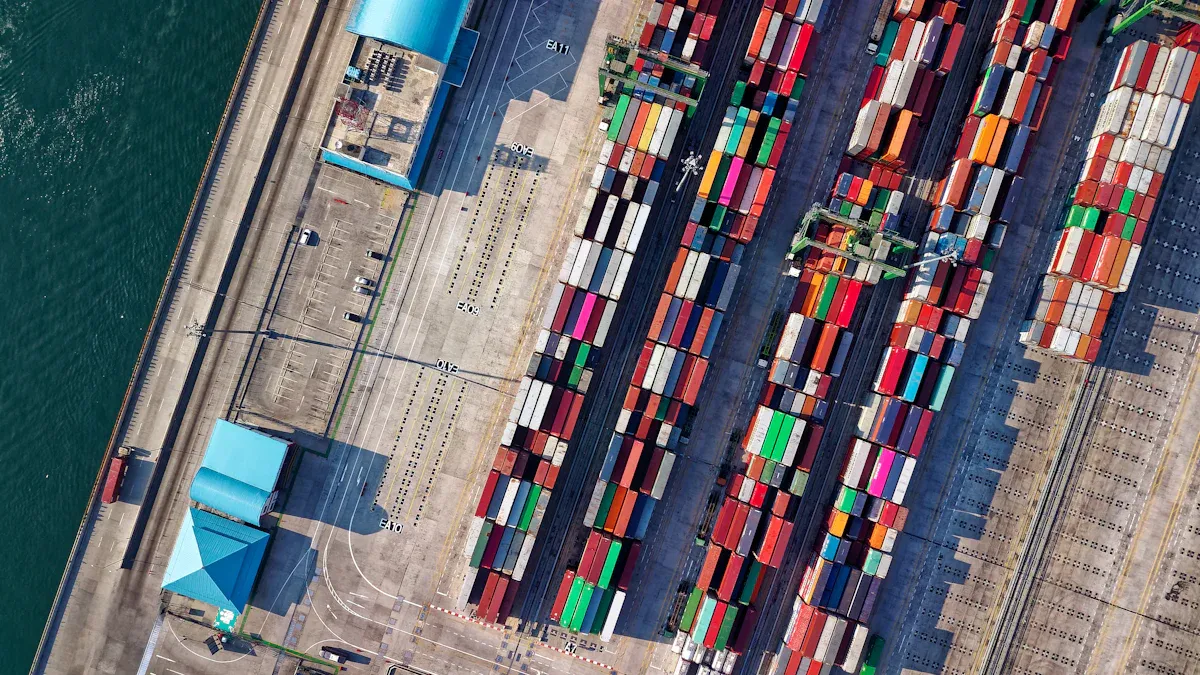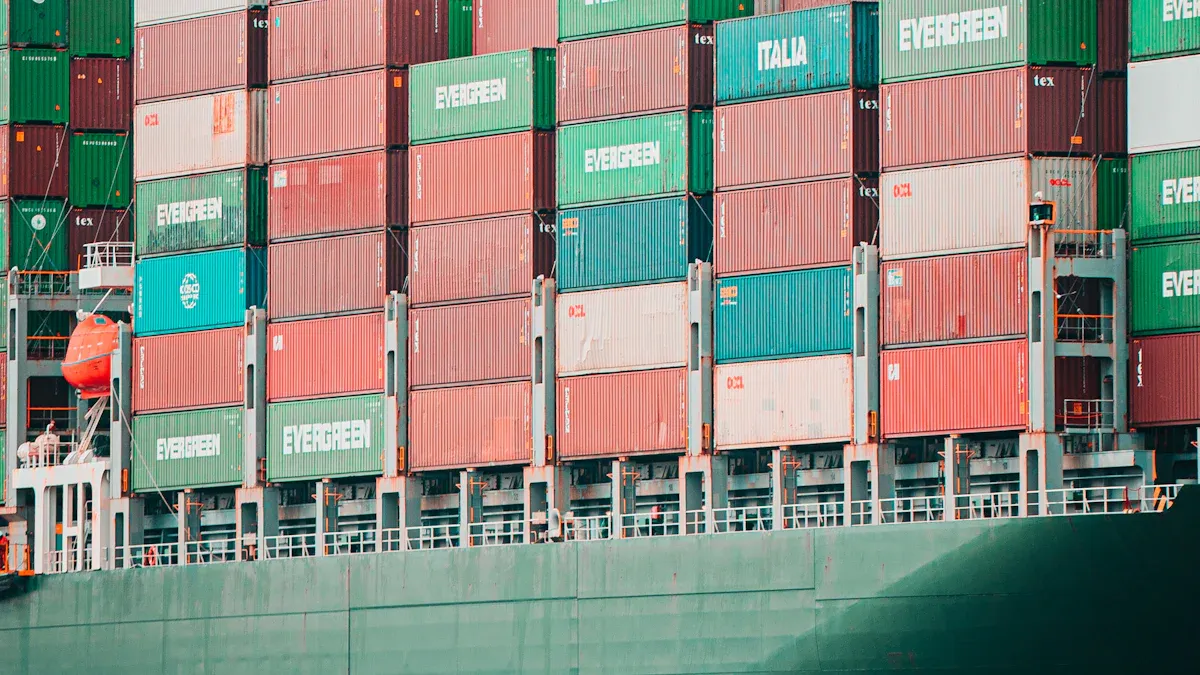Top Strategies for Streamlining Logistics Routes in 2025

Efficient logistics routes play a pivotal role in modern supply chains. Businesses that embrace route optimization software can reduce fuel costs, improve delivery times, and enhance customer satisfaction. For instance, fleet vehicles spend only 10% of their time driving, highlighting untapped efficiency potential.
Statistic/Insight | Description |
|---|---|
Delivery Time Impact | 87% of online buyers consider delivery time in their purchase decisions. |
Cost of Congestion | The cost of congestion for one truck in the US was $5,525 in 2019. |
Staying competitive means adopting tools that analyze traffic patterns, forecast weather, and adjust routes dynamically.
Key Takeaways
Use route planning tools to save fuel and deliver faster.
Check live data and forecasts to avoid traffic and bad weather.
Use technology to plan well and keep customers happy while saving money.
The Fundamentals of Logistics Route Optimization
Defining logistics routes and their importance
Logistics routes form the backbone of supply chain operations. These routes determine how goods move from warehouses to customers or distribution centers. Effective route planning ensures that deliveries are timely, cost-efficient, and environmentally friendly. Without proper planning, businesses risk delays, increased costs, and dissatisfied customers.
The core principles of route optimization focus on three key areas: orders, drivers, and transit.
Category | Core Principle |
|---|---|
Order/Delivery | Total number of deliveries, priority orders, and accurate addresses |
Driver | Availability, schedules, rates, and driver-specific knowledge |
Transit | Traffic patterns and restrictions |
By addressing these factors, businesses can improve time management and enhance delivery accuracy. Route optimization also allows companies to reorganize their operations effectively, maximizing productivity and customer satisfaction.
Key benefits of route optimization for businesses
Getting started with route optimization offers measurable advantages. For example, a logistics company reduced fuel expenses by 15%, reallocating savings to other operations. Similarly, Amazon improved delivery accuracy by 30%, boosting customer satisfaction and repeat business.
Here are some key benefits:
Cost savings: Businesses minimize travel distances and avoid congested areas, significantly reducing operational costs.
Improved delivery times: Enhanced route planning ensures timely deliveries, which strengthens customer trust.
Sustainability: Reducing unnecessary mileage lowers carbon emissions by up to 20%.
Increased efficiency: Tracking trucks and optimizing schedules improve service levels and overall productivity.
Companies like UPS and Coca-Cola have demonstrated the power of route optimization. UPS saved millions of gallons of fuel annually, while Coca-Cola reduced delivery miles, cutting costs and improving service. These examples highlight how route planning and optimization can transform logistics operations.
Overcoming Challenges in Logistics Routing
Addressing traffic, weather, and external disruptions
Logistics routes often face disruptions from traffic congestion, unpredictable weather, and other external factors. These challenges can delay deliveries, increase costs, and reduce overall efficiency. For instance, weather accounts for 23% of all roadway delays, leading to billions of lost hours and higher fuel consumption. Heavy rain, snow, or ice can force road closures, requiring rerouting and delaying shipments. Extreme weather events may even damage goods, further disrupting supply chains.
To overcome these obstacles, you can adopt strategies that enhance route optimization. Real-time adaptation tools help you respond to traffic congestion or road closures instantly. Predictive analytics can anticipate weather-related disruptions, allowing you to plan alternative routes in advance. By integrating these technologies, you ensure on-time delivery while minimizing operational costs.
Tip: Use dynamic routing systems to adjust transportation and delivery plans in real time. This approach reduces delays and improves efficiency.
Balancing cost-efficiency with customer satisfaction
Balancing cost-efficiency with customer satisfaction is critical in logistics. Rising fuel prices and increasing demand for faster deliveries make this balance even more challenging. Customers expect on-time delivery, but cutting costs without compromising service quality requires careful planning.
You can optimize logistics processes to enhance efficiency while meeting customer expectations. Leverage technology for better data analytics and performance monitoring. Set clear service level expectations to manage customer demands effectively. Prioritize order accuracy and timeliness to maintain trust and satisfaction. Proactive customer support also helps address inquiries and concerns, ensuring a positive experience.
By focusing on these strategies, you achieve cost savings without sacrificing service quality. This balance strengthens your reputation and keeps your operations competitive.
Advanced Strategies for Route Optimization

Leveraging AI and machine learning in route optimization
AI and machine learning have revolutionized route optimization techniques, making logistics routes more efficient and reliable. These technologies analyze vast amounts of data to identify patterns and predict optimal routes. For example:
AI uses machine learning to adjust routes in real time, reducing delays caused by traffic or accidents.
Predictive analytics enhance decision-making, ensuring faster deliveries and lower costs.
AI addresses common challenges like inaccurate delivery addresses and warehouse inefficiencies.
By implementing intelligent route optimization, you can dynamically adjust routes based on real-time data, improving fleet management and overall efficiency.
Dynamic routing for real-time adjustments
Dynamic route optimization allows you to adapt to sudden changes, ensuring successful route optimization even in unpredictable conditions. This routing technology calculates efficient routes while considering real-time factors like traffic and weather.
Benefit | Description |
|---|---|
Enhanced Efficiency | Dynamic routing ensures reliable service by optimizing delivery processes in real time. |
Cost Savings | Efficient routes reduce travel time and fuel consumption. |
Improved Customer Satisfaction | Accurate ETAs and real-time updates enhance transparency and reliability. |
Dynamic route adjustments also provide flexibility to handle ad-hoc requests or disruptions, ensuring your fleet management remains seamless.
Predictive analytics for proactive logistics planning
Predictive analytics empowers you to anticipate challenges and plan accordingly. By analyzing historical data, predictive models forecast potential issues like traffic congestion or weather disruptions. This allows you to devise alternative routes in advance.
With accurate demand forecasts, you can make informed decisions about production levels, staffing, and resource allocation. Proactive inventory management reduces stockouts and overstock situations, while risk predictions enable preemptive actions to mitigate supply chain disruptions. These insights improve route efficiency and streamline planning efficient routes.
Integrating IoT for real-time tracking and updates
IoT plays a critical role in intelligent route optimization by providing real-time updates and accurate tracking. IoT-enabled GPS trackers monitor vehicle locations with precision, eliminating uncertainty. This technology also tracks vehicle health and fuel consumption, optimizing route planning based on traffic and weather conditions.
Real-time updates sent to mobile devices allow you to respond quickly to potential re-routes, minimizing delays. By integrating IoT into your routing technology, you enhance fleet management and ensure successful route optimization.
Industry-Specific Applications of Route Optimization
E-commerce and last-mile delivery innovations
E-commerce businesses rely heavily on efficient last mile deliveries to meet customer expectations. Innovations in this area have transformed how delivery routes are planned and executed. Autonomous vehicles and drones now handle deliveries in urban areas, reducing human intervention and improving speed. AI-powered real-time tracking systems provide transparency, allowing you to monitor delivery routes and ensure timely arrivals. Urban warehousing and micro-fulfillment centers bring goods closer to customers, cutting down on transit times.
Additionally, hybrid fleet management combines company-owned vehicles with third-party providers to optimize operations. This approach ensures flexibility during peak demand periods. Real-time tracking using IoT and GPS technology enhances efficiency by providing accurate updates on delivery progress. These advancements make last mile delivery faster, more reliable, and cost-effective.
Tip: Adopting smart technologies like drones and AI can significantly improve your last mile delivery performance.
Optimizing logistics routes for perishable goods
Transporting perishable goods presents unique challenges. Seasonal changes often require adjustments to maintain temperature control during extreme weather. Regulatory compliance adds another layer of complexity, as strict guidelines aim to prevent spoilage and contamination. Advanced tracking systems and temperature-controlled vehicles help you meet these requirements.
Market fluctuations in demand and fuel prices further complicate route planning for perishables. Agile forecasting tools and operational strategies allow you to adapt quickly. By optimizing delivery routes, you can reduce transit times and ensure goods reach their destination fresh and intact. This approach minimizes waste and enhances customer satisfaction.
Applications in automotive and heavy equipment logistics
The automotive and heavy equipment industries benefit greatly from advanced route optimization techniques. AI and machine learning analyze data to identify the most efficient delivery routes. Predictive analytics forecast potential disruptions, enabling proactive adjustments. GPS and telematics systems provide real-time data, helping drivers avoid delays and reduce fuel consumption.
Dynamic routing ensures that deliveries stay on schedule, even when unexpected challenges arise. These technologies not only improve efficiency but also enhance customer satisfaction by ensuring timely deliveries. Optimized logistics routes in this sector lead to significant cost savings and better resource utilization.
Selecting the Best Route Optimization Software
Key features of effective route optimization software
When choosing route optimization software, you need to focus on features that enhance efficiency and streamline operations. Effective software should offer tools that simplify planning and improve delivery accuracy. Here are some key features to look for:
Key Feature | Description |
|---|---|
Automated Route Planning | Dynamically optimizes routes based on distance, traffic, and other factors. |
Real-Time Tracking | Offers live updates on vehicle locations to ensure timely deliveries. |
Integration Capabilities | Connects easily with CRM and ERP systems for streamlined operations. |
Scalability | Supports businesses as they grow, accommodating increasing delivery demands. |
Data Analytics | Provides insights into performance metrics and areas for improvement. |
These features ensure that your route optimizer adapts to your needs, helping you deliver goods efficiently while reducing costs.
Evaluating scalability and cost-effectiveness
Scalability and cost-effectiveness are critical when choosing route optimization software. You should evaluate whether the software can handle your current delivery volumes and grow with your business. Consider these factors:
Features Offered: Look for essential functionalities like real-time traffic updates and multi-stop optimization.
Ease of Use: Ensure the software is user-friendly for both dispatchers and drivers.
Scalability: Check if the software can accommodate future growth.
Cost: Compare pricing models and features to find the best value.
To measure success, track metrics like delivery times, fuel savings, and customer satisfaction scores. These indicators help you assess the software’s impact on your operations.
Integration with JUSDA's warehouse solutions
Integrating route optimization software with warehouse solutions like JUSDA’s JusLink platform can transform your logistics operations. This integration reduces transportation costs by minimizing empty miles and improving efficiency. It also ensures timely inventory availability, boosting customer satisfaction.
Advantage | Description |
|---|---|
Reduce transportation cost & improve efficiency | Automated route mapping minimizes empty miles, leading to reduced fuel consumption and overall operating costs. |
Improved inventory availability boosting store service | Efficient route planning ensures timely inventory availability, enhancing customer satisfaction and repeat business. |
Faster route and trailer plan by AI & ML based software | Advanced algorithms optimize routes and trailer plans quickly, improving delivery times and operational efficiency. |
Reduce carbon footprint | Efficient routing strategies minimize fuel use, contributing to sustainability efforts. |
By combining advanced route optimization software with JUSDA’s solutions, you can achieve seamless logistics operations and stay ahead in a competitive market.
JUSDA's Role in Revolutionizing Logistics Routes

How JUSDA's JusLink platform enhances route optimization
JUSDA's JusLink platform transforms route optimization by integrating advanced technologies and providing end-to-end visibility. This platform empowers you to make informed decisions, streamline operations, and enhance logistics routes. Its features include:
Feature | Description |
|---|---|
End-to-End Visibility | Provides comprehensive oversight of supply chain operations, enhancing decision-making. |
Advanced Technologies | Utilizes RFID and WMS for improved tracking and management of logistics. |
Automation in Warehousing | Reduces manual errors and increases productivity, leading to more efficient route planning. |
By leveraging these capabilities, JusLink acts as a powerful route optimizer. It ensures that your logistics operations remain efficient, accurate, and adaptable to changing conditions. This platform also integrates seamlessly with other systems, enabling you to optimize planning and reduce operational costs.
The impact of JUSDA's global warehouse network on logistics efficiency
JUSDA's extensive global warehouse network plays a crucial role in improving logistics efficiency. This network offers comprehensive services tailored to meet diverse market needs. Key benefits include:
Enhanced operations through advanced digital solutions.
Real-time tracking for unparalleled visibility.
Analytics that enable proactive issue management.
In North America, JUSDA focuses on cross-border VMI services and consolidation centers, which improve response times. Localization strategies further strengthen its competitive edge by addressing specific market demands. These efforts ensure seamless supply chain operations, making JUSDA a leader in logistics route optimization.
Note: JUSDA's global presence and innovative solutions allow you to stay ahead in a competitive market while reducing costs and improving delivery times.

JUSDA Solutions
To provide you with professional solutions and quotations.
Adopting advanced route optimization strategies offers businesses significant benefits, including cost reduction, enhanced efficiency, and improved customer satisfaction. Tools like JUSDA's JusLink platform streamline planning and provide end-to-end visibility, ensuring a competitive edge. As AI, blockchain, and sustainability reshape logistics, embracing innovation will define success in 2025’s dynamic supply chain landscape.
See Also
Exploring 5 Key Trends Shaping Future Supply Chain Efficiency
Discover 5 Cutting-Edge Techniques for Supply Chain Optimization
Unlocking Logistics Savings: Essential Tips for Supply Chain Success
Transforming Future Logistics Through Advanced Digital Technologies
